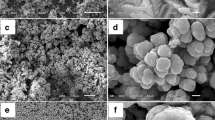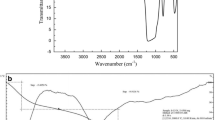Abstract
A novel non-enzymatic glucose sensor based on poly(caffeic acid)@multi-walled carbon nanotubes decorated with CuO nanoparticles (PCA@MWCNT-CuO) was developed. The described approach involves the complexation/accumulation of Cu(II) on PCA@MWCNT followed by electrochemical CuO deposition in an alkaline electrolyte. The morphology and surface characteristics of the nanomaterial were determined by transmission electron microscopy (TEM), energy-dispersive X-ray spectroscopy (EDS), atomic force microscopy (AFM), Raman spectroscopy, and inductively coupled plasma mass spectrometry (ICP-MS). A hybrid-support sensor device was then developed to assess the glucose concentration in different solutions. The sensitivity of the electrode is 2412 μA mM−1 cm−2. The electrode exhibited a broad linear range of 2 µM to 9 mM and a low limit of detection (LOD) of 0.43 µM (relative standard deviation, RSD = 2.3%) at + 0.45 V vs Ag/AgCl. The excellent properties obtained for glucose detection were most likely due to the synergistic effect of the combination of individual components: poly(caffeic acid), MWCNTs, and CuO. Good accuracy and high precision were demonstrated for quantifying glucose concentrations in human serum and blood samples (the recovery ranged from 95.0 to 99.5%). The GC/PCA@MWCNT-CuO sensor represents a novel, simple, and low-cost approach to the fabrication of devices for amperometric sensing of glucose.
Graphical abstract







Similar content being viewed by others
References
Li R, Liu X, Wang H, Wu Y, Chan KC, Lu Z (2019) Sandwich nanoporous framework decorated with vertical CuO nanowire arrays for electrochemical glucose sensing. Electrochim Acta 299:470–478
Lu LM, Zhang XB, Shen GL, Yu RQ (2012) Seed-mediated synthesis of copper nanoparticles on carbon nanotubes and their application in nonenzymatic glucose biosensors. Anal Chim Acta 715:99–104
Karaman C, Karaman O, Atar N, Yola ML (2022) A molecularly imprinted electrochemical biosensor based on hierarchical Ti2Nb10O29 (TNO) for glucose detection. Microchim Acta 189:24
Jędrzak A, Rębiś T, Kuznowicz M, Jesionowski T (2019) Bio-inspired magnetite/lignin/polydopamine-glucose oxidase biosensing nanoplatform. From synthesis, via sensing assays to comparison with other glucose testing techniques. Int. J Biol Macromol 127:677–682
Kuznowicz M, Jędrzak A, Rębiś T, Jesionowski T (2021) Biomimetic magnetite/polydopamine/β-cyclodextrins nanocomposite for long-term glucose measurements. Biochem Eng J 127:108127
Lin KC, Lin YC, Chen SM (2013) A highly sensitive nonenzymatic glucose sensor based on multi-walled carbon nanotubes decorated with nickel and copper nanoparticles. Electrochim Acta 96:164–172
Xu D, Zhu C, Meng X, Chen Z, Li Y, Zhang D, Zhu S (2018) Design and fabrication of Ag-CuO nanoparticles on reduced graphene oxide for non-enzymatic detection of glucose. Sens Actuators B Chem 265:435–442
Maaoui H, Teodoresu F, Wang Q, Pan GH, Addad A, Chtourou R, Szunerits S, Boukherroub R (2016) Non-enzymatic glucose sensing using carbon quantum dots decorated with copper oxide nanoparticles. Sensors 16:1–10
Hassan MH, Vyas C, Grieve B, Bartolo P (2021) Recent advances in enzymatic and non-enzymatic electrochemical glucose sensing. Sensors 21(14):4672
Yang Z, Feng J, Qiao J, Yan Y, Yu Q, Sun K (2012) Copper oxide nanoleaves decorated multi-walled carbon nanotube as platform for glucose sensing. Anal Methods 4(7):1924
Li T, Xu J, Zhao L, Shen S, Yuan M, Liu W, Tu Q, Yu R, Wang J (2016) Au nanoparticles/poly(caffeic acid) composite modified glassy carbon electrode for voltammetric determination of acetaminophen. Talanta 159:356–364
Rębiś T, Kuznowicz M, Jędrzak A, Milczarek G, Jesionowski T (2021) Design and fabrication of low potential NADH-sensor based on poly(caffeic acid)@multi-walled carbon nanotubes. Electrochim Acta 386:138384
Monahana J, Wilker JJ (2003) Specificity of metal ion cross-linking in marine mussel adhesives. Chem Commun 14:1672–1673
Le WZ, Liu YQ (2009) Preparation of nano-copper oxide modified glassy carbon electrode by a novel film plating/potential cycling method and its characterization. Sens Actuators B Chem 141:147–153
Yang J, Jiang LC, de Zhang W, Gunasekaran S (2010) A highly sensitive non-enzymatic glucose sensor based on a simple two-step electrodeposition of cupric oxide (CuO) nanoparticles onto multi-walled carbon nanotube arrays. Talanta 82:25–33
Liu Y, Wang W, Gu L, Wang Y, Ying Y, Mao Y, Sun L, Peng X (2013) Flexible CuO nanosheets/reduced-graphene oxide composite paper: binder-free anode for high-performance lithium-ion batteries. ACS Appl Mater Interfaces 9850−9855
Hussain MM, Abdullah MA, Rahman MM (2020) A non-enzymatic electrochemical approach for L-lactic acid sensor development based on CuO MWCNT nanocomposites modified with a Nafion matrix. New J Chem 9775−9787
Qi H, Liu J, Mäder E (2014) Smart cellulose fibers coated with carbon nanotube networks. Fibers 2:295–307
Saito R, Grüneis A, Samsonidze GG, Brar VW, Dresselhaus G, Dresselhaus MS, Jorio A, Cançado LG, Fantini C, Pimenta MA, Souza Filho AG (2003) Double resonance Raman spectroscopy of single-wall carbon nanotubes. New J Phys 5:157.1-157.15
Jędrzak A, Kuznowicz M, Rębiś T, Jesionowski T (2022) Portable glucose biosensor based on polynorepinephrine@magnetite nanomaterial integrated with a smartphone analyzer for point-of-care application. Bioelectrochemistry 145:108071
Bard AJ, Faulkner RL (1980) Electrochemical methods: fundamental and applications. Wiley, New York, pp 346–350
Li K, Fan G, Yang L, Li F (2014) Novel ultrasensitive non-enzymatic glucose sensors based on controlled flower-like CuO hierarchical films. Sens Actuators B Chem 199:175–182
Wu HX, Cao WM, Li Y, Liu G, Wen Y, Yang HF, Yang SP (2010) In situ growth of copper nanoparticles on multiwalled carbon nanotubes and their application as non-enzymatic glucose sensor materials Electrochim. Acta 55(11):3734–3740
Muralikrishna S, Sureshkumar K, Yan Z, Fernandez C, Ramakrishnappa T (2015) Non-enzymatic amperometric determination of glucose by CuO nanobelt graphene composite modified glassy carbon electrode. J Braz Chem Soc 26:1632–1641
Chen X, Wu G, Cai Z, Oyam M, Chen X (2014) Advances in enzyme-free electrochemical sensors for hydrogen peroxide, glucose, and uric acid. Microchim Acta 181:689–705
Ramachandran K, Raj Kumar T, Babu KJ, Gnana Kumar G (2016) Ni-Co bimetal nanowires filled multiwalled carbon nanotubes for the highly sensitive and selective non-enzymatic glucose sensor applications. Sci Rep 6:1–12
Tang Y, Liu Q, Jiang Z, Yang X, Wei M, Zhang M (2017) Non-enzymatic glucose sensor based on icosahedron AuPd@CuO core-shell nanoparticles and MWCNT. Sens Actuators B Chem 251:1096–1103
Amirzadeh Z, Javadpour S, Shariat MH, Knibbe R (2018) Non-enzymatic glucose sensor based on copper oxide and multi-wall carbon nanotubes using PEDOT: PSS matrix. Synth Met 245:160–166
Figiela M, Wysokowski M, Galiński M, Jesionowski T, Stępniak I (2018) Synthesis and characterization of novel copper oxide-chitosan nanocomposites for non-enzymatic glucose sensing. Sens Actuators B Chem 272:296–307
Cao F, Guo S, Ma H, Yang G, Yang S, Gong J (2011) Highly sensitive non-enzymatic glucose sensor based on electrospun copper oxide-doped nickel oxide composite microfibers. Talanta 86:214–220
Kang X, Mai Z, Zou X, Cai P, Mo J (2007) A sensitive non-enzymatic glucose sensor in alkaline media with a copper nanocluster/multiwall carbon nanotube-modified glassy carbon electrode. Anal Biochem 363:143–150
Toghill K, Compton R (2010) Electrochemical non-enzymatic glucose sensors: a perspective and an evaluation. Int J Electrochem Sci 5:1246–1301
Ayaz S, Karakaya S, Emir G, Dilgin DG, Dilgin Y (2020) A novel enzyme-free FI-amperometric glucose biosensor at Cu nanoparticles modified graphite pencil electrode. Microchem J 154:104586
Lin X, Wang Y, He W, Ni Y, Kokot S (2017) Nano-composite of Co3O4 and Cu with enhanced stability and catalytic performance for non-enzymatic electrochemical glucose sensors. RSC Adv 7:54460–54467
Wang F, Hu S, Shi F, Huang K, Li J (2020) A non-enzymatic sensor based on Fc-CHIT/CNT@Cu nanohybrids for electrochemical detection of glucose. Polymers 12:1–12
Funding
This work was financed and prepared as part of a research project supported by the National Science Centre Poland, no. 2017/27/B/ST8/01506.
Author information
Authors and Affiliations
Corresponding authors
Ethics declarations
Ethics approval and consent to participate
All procedures performed in studies involving human participants were in accordance with the ethical standards of the institutional and/or national research committee and with the 1964 Helsinki Declaration and its later amendments or comparable ethical standards. This article does not contain any studies with animals performed by any of the authors. Informed consent was obtained from all individual participants included in the study.
Conflict of interest
The authors declare no competing interests.
Additional information
Publisher's Note
Springer Nature remains neutral with regard to jurisdictional claims in published maps and institutional affiliations.
Supplementary Information
Below is the link to the electronic supplementary material.
Rights and permissions
About this article
Cite this article
Kuznowicz, M., Rębiś, T., Jędrzak, A. et al. Glucose determination using amperometric non-enzymatic sensor based on electroactive poly(caffeic acid)@MWCNT decorated with CuO nanoparticles. Microchim Acta 189, 159 (2022). https://doi.org/10.1007/s00604-022-05256-y
Received:
Accepted:
Published:
DOI: https://doi.org/10.1007/s00604-022-05256-y




